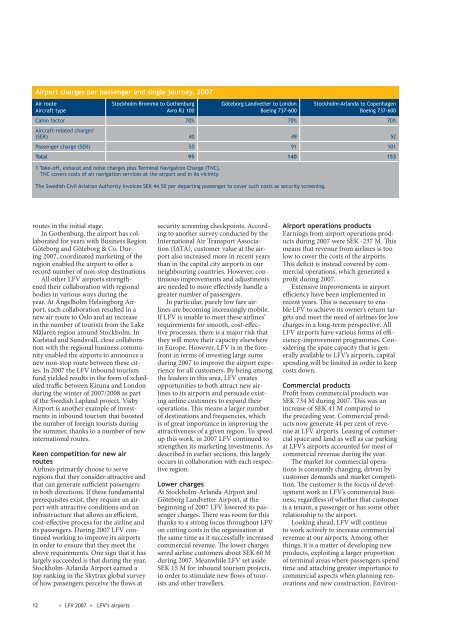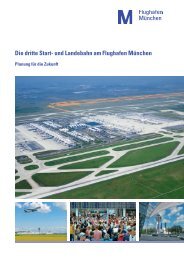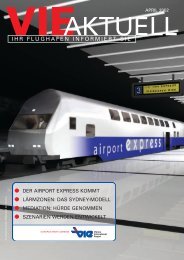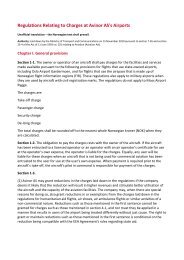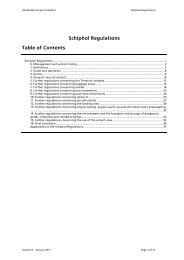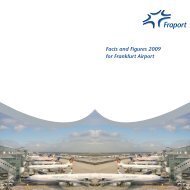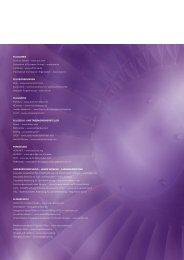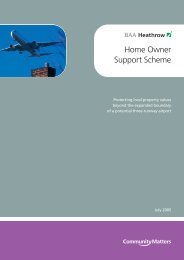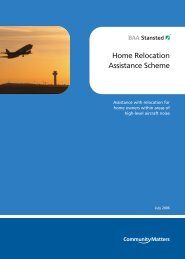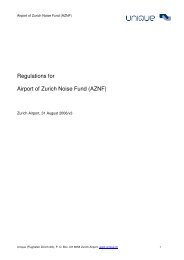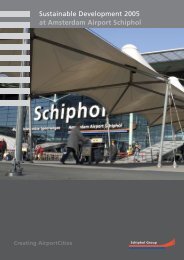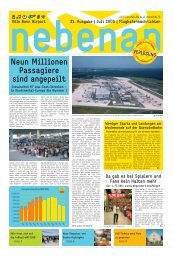The LFV Group - Airport Mediation - Home
The LFV Group - Airport Mediation - Home
The LFV Group - Airport Mediation - Home
- No tags were found...
Create successful ePaper yourself
Turn your PDF publications into a flip-book with our unique Google optimized e-Paper software.
<strong>Airport</strong> charges per passenger and single journey, 2007Air routeAircraft typeStockholm-Bromma to GothenburgAvro RJ 100Göteborg Landvetter to LondonBoeing 737-600Stockholm-Arlanda to CopenhagenBoeing 737-600Cabin factor 70% 70% 70%Aircraft-related charges 1(SEK) 40 49 52Passenger charge (SEK) 55 91 101Total 95 140 1531 Take-off, exhaust and noise charges plus Terminal Navigation Charge (TNC).TNC covers costs of air navigation services at the airport and in its vicinity.<strong>The</strong> Swedish Civil Aviation Authority invoices SEK 44.50 per departing passenger to cover such costs as security screening.routes in the initial stage.In Gothenburg, the airport has collaboratedfor years with Business RegionGöteborg and Göteborg & Co. During2007, coordinated marketing of theregion enabled the airport to offer arecord number of non-stop destinations.All other <strong>LFV</strong> airports strengthenedtheir collaboration with regionalbodies in various ways during theyear. At Ängelholm Helsingborg <strong>Airport</strong>,such collaboration resulted in anew air route to Oslo and an increasein the number of tourists from the LakeMälaren region around Stockholm. InKarlstad and Sundsvall, close collaborationwith the regional business communityenabled the airports to announce anew non-stop route between these cities.In 2007 the <strong>LFV</strong> inbound tourismfund yielded results in the form of scheduledtraffic between Kiruna and Londonduring the winter of 2007/2008 as partof the Swedish Lapland project. Visby<strong>Airport</strong> is another example of investmentsin inbound tourism that boostedthe number of foreign tourists duringthe summer, thanks to a number of newinternational routes.Keen competition for new airroutesAirlines primarily choose to serveregions that they consider attractive andthat can generate sufficient passengersin both directions. If these fundamentalprerequisites exist, they require an airportwith attractive conditions and aninfrastructure that allows an efficient,cost-effective process for the airline andits passengers. During 2007 <strong>LFV</strong> continuedworking to improve its airportsin order to ensure that they meet theabove requirements. One sign that it haslargely succeeded is that during the year,Stockholm-Arlanda <strong>Airport</strong> earned atop ranking in the Skytrax global surveyof how passengers perceive the flows atsecurity screening checkpoints. Accordingto another survey conducted by theInternational Air Transport Association(IATA), customer value at the airportalso increased more in recent yearsthan in the capital city airports in ourneighbouring countries. However, continuousimprovements and adjustmentsare needed to more effectively handle agreater number of passengers.In particular, purely low fare airlinesare becoming increasingly mobile.If <strong>LFV</strong> is unable to meet these airlines’requirements for smooth, cost-effectiveprocesses, there is a major risk thatthey will move their capacity elsewherein Europe. However, <strong>LFV</strong> is in the forefrontin terms of investing large sumsduring 2007 to improve the airport experiencefor all customers. By being amongthe leaders in this area, <strong>LFV</strong> createsopportunities to both attract new airlinesto its airports and persuade existingairline customers to expand theiroperations. This means a larger numberof destinations and frequencies, whichis of great importance in improving theattractiveness of a given region. To speedup this work, in 2007 <strong>LFV</strong> continued tostrengthen its marketing investments. Asdescribed in earlier sections, this largelyoccurs in collaboration with each respectiveregion.Lower chargesAt Stockholm-Arlanda <strong>Airport</strong> andGöteborg Landvetter <strong>Airport</strong>, at thebeginning of 2007 <strong>LFV</strong> lowered its passengercharges. <strong>The</strong>re was room for thisthanks to a strong focus throughout <strong>LFV</strong>on cutting costs in the organisation atthe same time as it successfully increasedcommercial revenue. <strong>The</strong> lower chargessaved airline customers about SEK 60 Mduring 2007. Meanwhile <strong>LFV</strong> set asideSEK 15 M for inbound tourism projects,in order to stimulate new flows of touristsand other travellers.<strong>Airport</strong> operations productsEarnings from airport operations productsduring 2007 were SEK -237 M. Thismeans that revenue from airlines is toolow to cover the costs of the airports.This deficit is instead covered by commercialoperations, which generated aprofit during 2007.Extensive improvements in airportefficiency have been implemented inrecent years. This is necessary to enable<strong>LFV</strong> to achieve its owner’s return targetsand meet the need of airlines for lowcharges in a long-term perspective. All<strong>LFV</strong> airports have various forms of efficiency-improvementprogrammes. Consideringthe spare capacity that is generallyavailable to <strong>LFV</strong>’s airports, capitalspending will be limited in order to keepcosts down.Commercial productsProfit from commercial products wasSEK 734 M during 2007. This was anincrease of SEK 41 M compared tothe preceding year. Commercial productsnow generate 44 per cent of revenueat <strong>LFV</strong> airports. Leasing of commercialspace and land as well as car parkingat <strong>LFV</strong>’s airports accounted for most ofcommercial revenue during the year.<strong>The</strong> market for commercial operationsis constantly changing, driven bycustomer demands and market competition.<strong>The</strong> customer is the focus of developmentwork in <strong>LFV</strong>’s commercial business,regardless of whether that customeris a tenant, a passenger or has some otherrelationship to the airport.Looking ahead, <strong>LFV</strong> will continueto work actively to increase commercialrevenue at our airports. Among otherthings, it is a matter of developing newproducts, exploiting a larger proportionof terminal areas where passengers spendtime and attaching greater importance tocommercial aspects when planning renovationsand new construction. Environ-12 > <strong>LFV</strong> 2007 < <strong>LFV</strong>’s airports


